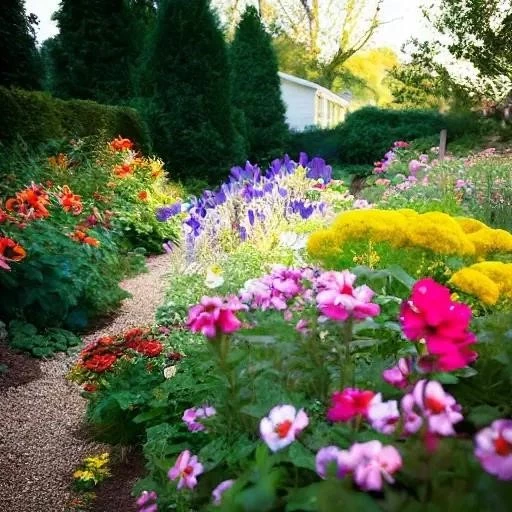As the vibrant tapestry of the seasons unfurls, casting its alluring spell across our landscapes, an irresistible urge often takes root within us: the desire to cultivate beauty. For countless enthusiasts and burgeoning horticulturists alike, the pivotal question echoes through the warming air: what to plant in the flower garden now? This isn’t merely a practical query concerning botanical selection; it’s an exhilarating invitation to sculpt living art, to infuse our personal sanctuaries with an unparalleled symphony of colors, textures, and fragrances, transforming even the most unassuming plots into breathtaking spectacles of natural splendor. The present moment, a fleeting window of opportunity, holds immense potential for crafting a garden that not only flourishes spectacularly in the immediate future but also promises enduring joy and visual delight for seasons to come.
Embracing the profound wisdom of nature’s rhythms, successful gardening hinges on understanding the delicate interplay between timing, climate, and plant physiology. To truly maximize your efforts and ensure a thriving floral haven, one must look beyond superficial aesthetics and delve into the foundational principles of horticultural excellence. By integrating insights from seasoned experts and adopting proven strategies, you can meticulously prepare your garden canvas, selecting species destined to thrive and creating an environment where every petal, stem, and leaf contributes to a harmonious, flourishing ecosystem. This transformative journey, commencing with thoughtful planting decisions today, promises a verdant reward, enriching both your outdoor spaces and your spirit with unparalleled natural beauty.
Here’s a crucial guide to help you navigate your planting journey:
| Category | Key Considerations for ‘Now’ Planting | Details & Recommendations | Official Reference (Example) |
|---|---|---|---|
| Season & Climate | Understand your local hardiness zone and current weather patterns. | Ensure the risk of frost has passed for tender annuals. Consider soil temperature for optimal germination of seeds. | USDA Plant Hardiness Zone Map |
| Soil Health | The foundation of any thriving garden. | Test your soil pH and nutrient levels. Amend with compost or well-rotted manure to improve structure, drainage, and fertility. | Gardening Know How ⎯ Soil Testing |
| Sunlight Exposure | Match plants to their light requirements. | Observe your garden throughout the day to identify full sun (6+ hours), partial sun/shade (3-6 hours), and full shade areas. | The Old Farmer’s Almanac ⎯ Light Requirements |
| Plant Types | Choose wisely for immediate impact and long-term beauty. | Annuals: (Petunias, Marigolds, Impatiens) for immediate color. Perennials: (Hostas, Daylilies, Coneflowers) for returning beauty. Bulbs: (Summer-blooming like Gladiolus, Dahlias) for staggered displays. | Better Homes & Gardens ⎻ Types of Flowers |
| Watering & Drainage | Essential for plant survival and health. | Ensure good drainage to prevent root rot. Plan for efficient watering, considering drip irrigation for water conservation. | EPA WaterSense ⎯ Watering Tips |
The Art of Selection: Crafting Your Botanical Masterpiece
Having meticulously prepared your garden’s foundation, the exhilarating phase of plant selection truly begins. This isn’t just about picking pretty flowers; it’s about curating a living symphony, balancing vibrant annuals that offer instant gratification with robust perennials promising enduring beauty year after year. For immediate, splashy impact, consider planting well-established annuals such as cheerful marigolds, cascading petunias, or the ever-reliable impatiens. These floral powerhouses deliver an explosion of color, filling gaps and providing continuous blooms throughout the warmer months. Their transient nature allows for exciting experimentation each season, keeping your garden dynamic and fresh.
However, the true heart of a resilient and captivating flower garden lies in its perennials. Planting varieties like the majestic coneflowers, the elegant daylilies, or the shade-loving hostas now will establish their root systems, ensuring a spectacular return each spring. These foundational plants, having settled comfortably into their new homes, will grow stronger and more prolific with each passing year, offering a reliable backbone of beauty. Don’t overlook summer-blooming bulbs such as gladiolus, dahlias, or lilies; strategically planted, they can provide stunning, staggered displays, extending your garden’s peak appeal well into the late summer and early autumn. By thoughtfully layering these different plant types, you create a garden that continuously evolves, enchanting visitors with its unfolding beauty.
Beyond Blooms: Nurturing a Thriving Ecosystem
A truly exceptional flower garden extends far beyond its individual blossoms; it is a meticulously designed ecosystem, fostering life and promoting ecological balance. Incorporating plants that attract pollinators, such as bees, butterflies, and hummingbirds, is an incredibly effective strategy for enhancing your garden’s vitality. Lavender, butterfly bush, and salvia are not only visually stunning but also serve as vital food sources and habitats, contributing significantly to local biodiversity. This conscientious approach, often advocated by leading horticulturists, transforms your garden into a bustling hub of natural activity, a testament to sustainable living and environmental stewardship.
Furthermore, consider the strategic placement of plants based on their mature size, light requirements, and water needs. Taller specimens should be positioned at the back of beds, gradually stepping down to shorter varieties at the front, creating depth and visual interest. By integrating AI-driven insights from advanced horticultural databases, gardeners are increasingly optimizing plant arrangements for maximum growth and minimal resource consumption. This forward-thinking methodology not only conserves precious resources but also ensures each plant receives its optimal share of sunlight and nutrients, minimizing competition and fostering robust growth. Watering practices, too, demand attention; deep, infrequent watering encourages stronger root development, making plants more resilient to dry spells.
The Ever-Evolving Canvas: Design Principles and Future Visions
Designing a flower garden is akin to painting a vast, verdant canvas, where each stroke of color and texture contributes to the overarching masterpiece. Think about color schemes: perhaps a serene monochromatic palette of whites and silvers, or a bold, vibrant explosion of reds, oranges, and yellows. Consider varying leaf shapes and plant heights to add intricate layers of visual interest, ensuring that the garden remains captivating even when specific blooms fade. The concept of succession planting is remarkably effective for maintaining continuous visual appeal; as one plant finishes its bloom cycle, another is just beginning to unfurl its petals, ensuring there’s always something spectacular to admire.
Looking ahead, the future of gardening is undeniably bright and innovative. Advancements in plant breeding are yielding disease-resistant varieties and plants with extended bloom times, making gardening more accessible and rewarding for everyone. Embracing native plants, which are inherently adapted to local conditions, reduces the need for excessive watering and pest control, aligning perfectly with sustainable gardening principles. The act of planting “now” is more than just a seasonal task; it’s an investment in future beauty, a tangible expression of hope, and a personal contribution to the health and vibrancy of our shared planet. So, seize this opportune moment, dig in with enthusiasm, and watch your vision of a stunning flower garden gloriously come to life!






